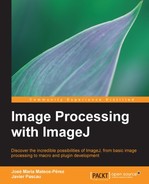As you have just seen in the previous example, there is a class that implements several filters, but the exact operation you want to implement will surely have to rely on many other classes. The best resource you can have at hand when coding a new ImageJ plugin is the ImageJ Java API, accessible at http://rsbweb.nih.gov/ij/developer/api/. This includes a list of all the classes and methods that can be used to develop your plugin.
We understand that this resource can be very arid at the beginning of your coding practices. Remember that reading code written by others is an excellent way of learning once you have a grip on the basics. A large number of plugins offered at http://rsbweb.nih.gov/ij/plugins/index.html also have their source code available. So, this is a great starting point to extend what you already know about plugin development.
Even though it is not the purpose of this book to offer an exhaustive list of all the classes and the operations they provide, in the following table we have listed some of them which are mostly used:
|
Operation |
Relevant classes or methods |
|---|---|
|
Filter |
|
|
Open / Save image |
|
|
Plot |
|
|
Run macro |
|
|
Histogram |
|
|
ROI handling |
|
|
Measurements |
|
|
Analyze Particles |
|
|
Get active image |
|
|
Get image IDs, get image by ID or name |
|
|
Capture mouse movements or clicks on the image |
